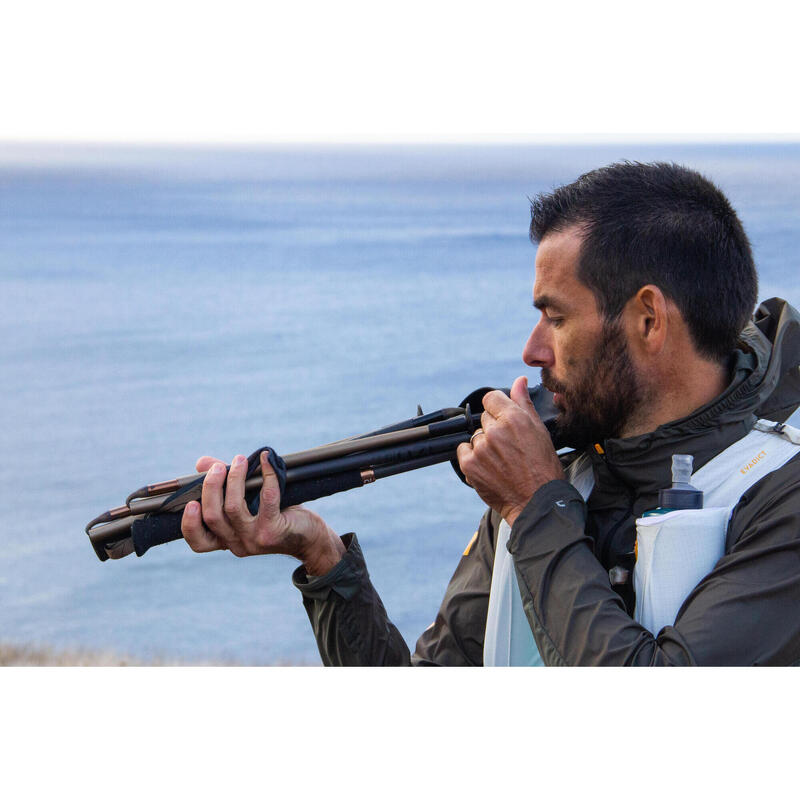Which size to choose for your trail poles?
To choose the right size of trail poles, your elbows must be at right angles when you hold the poles:
- Size of runner from 155 to 170 cm = Poles 110 cm
- Size of runner from 171 to 181 cm = Poles 120 cm
- Size of runner over 182 cm = Poles 130 cm
Poles designed to save you time!
The priority for runners when it comes to their poles: quick storage and deployment. That's why we've designed these very light poles (282g per pair). And so they don't get in the way during your run, our 110 cm poles measure 37 cm when folded (40 cm in size 130 cm and 43 cm in size 130 cm). Make your best runs with a light mind!
Weight of poles
Weight of sticks:
Size 110 cm: 141 grams per stick and 282 grams per pair
Size 120 cm: 148 grams per stick and 296 grams per pair
Size 130 cm: 154 grams per stick and 308 grams per pair
Dimensions of folded poles :
Size 110 cm: 37 cm folded
Size 120 cm: 40 cm folded
Size 130 cm: 43 cm folded
Why use trail poles?
Trail poles are designed to help you save energy on climbs, and to provide balance, stability and safety on technical sections. They also act as stabilizers and shock absorbers for braking on descents.
How do I unfold or fold the poles?
A simple push-button release allows the stick to be unfolded/folded at high speed, even in full motion.
Tested and approved!
Our poles were first tested in the laboratory to prove their durability. Our design team then put them to the test in real-life conditions with seasoned trail runners on the Sainte Victoire mountain.
The results enabled us to come up with these ultra-light, compact carbon trail poles that are very quick to fold and unfold: less than 2 seconds to unfold and less than 3 seconds to fold!
A comfortable handle that adapts to all hand grips.
The poles' handle is made of resistant and very comfortable EVA foam. The size of the handle has been designed to fit all hand grips. Longer, it allows both male and female traileurs to have not only a classic high grip, but also a comfortable low grip. To each his own, after all!
How do I run with trail poles?
Using poles for running is a fairly technical exercise that requires a bit of training. With the wrong technique, a trail runner starting out with poles runs the risk of getting the opposite effect and losing energy.
There are 2 ways of using trail poles, whether running downhill or uphill: simultaneously or alternately. Whether you use one or the other depends on the inclination of the slope and the space available for your poles.
Technique for running with trail poles at the same time:
Simultaneous running is a particularly useful technique when the gradient is steep. It allows you to take the weight off your thighs by lifting your body with your arms, or to hold it back and take the weight off your legs on the way down. You can take several strides between each stick planting. Remember to lean your body forward and press the poles firmly into the ground.
Technique for running with alternating trail poles:
The alternating technique is more appropriate when there's less space available and on gentler slopes. This technique requires less power and consists of alternating right and left legs. The opposite arm plants the stick in front, while the other arm is back and in the air. In this case, it's best not to push the stick too far forward to maintain a better cadence. Smaller steps are preferable for this more natural running technique.
Composition and repairability of trail poles:
The tube construction is ultra-light: 60% carbon fiber and 40% resin (to bond the fibers). The handle is made of 100% EVA foam and the hand strap of 100% polyester webbing. The tungsten carbide tip can be unscrewed and changed.
Maintenance tips
Proper care of your poles will help them perform at their best and extend their life.
After use, if any water has penetrated the pole, allow it to dry. If necessary, clean off any dust or mud with water or a soft brush.
Once perfectly dry, we recommend that you store your dry trail sticks in their special cover, in a room away from humidity and light, if possible in a well-ventilated area.























